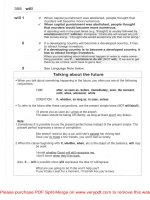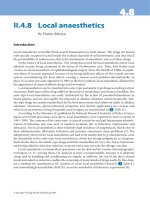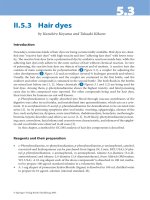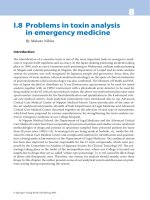Cytologic Detection of Urothelial Lesions - part 3 pdf
Bạn đang xem bản rút gọn của tài liệu. Xem và tải ngay bản đầy đủ của tài liệu tại đây (416.95 KB, 20 trang )
30 2. Diagnostic Categories
Figure 2.8. Normal Umbrella Cells—bladder washing: Instrumentation
will usually produce tissue fragments. The distinct cellular outlines, frothy
cytoplasm and relatively round, uniform nuclei testify to their benign na-
ture. (600x)
Benign Cellular Changes 31
Figure 2.9. Normal Cells: Bladder washing can produce sheets of normal
urothelial cells as well as single umbrella cells. This illustration displays
the smaller nuclei of the basal cells in comparison with the larger nuclei of
umbrella cells surrounding the tissue fragment. Note that the boundaries
of this tissue fragment are not smooth (compare with low grade papillary
lesion in Figure 3.7). (400x)
32 2. Diagnostic Categories
Figure 2.10. Normal Urothelial Cells—bladder washing: A fragment of
basal urothelial cells is surrounded by single umbrella cells. Note the
smaller nuclei of the basal cells when compared with the umbrella cells
which also feature prominent nucleoli. (600x)
Benign Cellular Changes 33
Figure 2.11. Lubricant—bladder washing: A fragment of lubricant is ad-
mixed with benign urothelial cells. (600x)
34 2. Diagnostic Categories
Figure 2.12. Reactive Urothelial Cells—bladder washing: Sheets of ep-
ithelial cells may be misinterpreted as neoplastic. Careful examination of
nuclear criteria, such as pale chromatin, prominent nucleoli, low NC ratios,
and a background of acute inflammation, contributes to the interpretation
of reactive/inflammatory cellular changes. (200x)
Benign Cellular Changes 35
Figure 2.13. Reactive Urothelial Cells—bladder washing: These urothe-
lial cells show slightly increased nuclear to cytoplasmic ratios and variably
sized nuclei. The cytoplasm is homogeneous and only mildly atypical.
(600x)
36 2. Diagnostic Categories
Figure 2.14. Reactive Urothelial Cells—bladder washing: Numerous
neutrophils, benign squamous cells and reactive urothelial cells are present.
Several of the cells show degeneration and nuclear hyperchromasia. The
nuclear to cytoplasmic ratio of the cells is not significantly increased.
(600x)
Benign Cellular Changes 37
Figure 2.15. Atypical Urothelial Cells Indeterminate for Neoplasia—
renal pelvic brushing: This fragment of urothelial cells was originally con-
sidered atypical without all the features of a low grade neoplasm. Note the
high NC ratios, variable nuclear shapes, and hyperchromasia. Other areas
of the same sample had more atypical cells reflecting the lesion, a Papillary
Urothelial Neoplasm of Low Malignant Potential. See Figure 3.2. (600x)
38 2. Diagnostic Categories
Figure 2.16. Reactive Urothelial Cells—bladder washing: A cluster of
reactive urothelial cells is seen. The cells are admixed with acute inflam-
matory cells and show either marked nuclear hyperchromasia and degen-
eration or a prominent nucleolus. (600x)
Benign Cellular Changes 39
Figure 2.17. Reactive Urothelial Cells—catheterized urine: These super-
ficial reactive urothelial cells show homogeneous cytoplasm and mildly
hyperchromatic nuclei. Note the low nuclear to cytoplasmic ratio, acute
inflammation and bacteria in the background. (600x)
40 2. Diagnostic Categories
Figure 2.18. Reactive Urothelial Cells—bladder washing: Degenerated
reactive urothelial cells are seen. These cells exhibit nuclear membrane
irregularities and nuclear hyperchromasia. These cells also have a large
amount of cytoplasm, indicative of their benign nature. (600x)
Benign Cellular Changes 41
Figure 2.19. Reactive Urothelial Cells—bladder washing: Degenerated
slightly atypical urothelial cells are seen. The cells exhibit only mildly
increased nuclear to cytoplasmic ratios and many of the cells contain
abundant cytoplasm. Note that the nuclear size is smaller than the size
of intermediate squamous cells. (600x)
42 2. Diagnostic Categories
Figure 2.20. Polyoma Virus—voided urine: If this is a rare cell in the spec-
imen, then one can presume a viral infection. However, nuclear changes
could be degeration in a cell from a high grade carcinoma and warrant
careful follow-up. (600x)
Benign Cellular Changes 43
Figure 2.21. Polyoma Virus—voided urine: An infected cell displays
overall cell enlargement, high NC ratio, and ground glass nucleus with
marginated chromatin. Compare the infected cell with the adjacent benign
urothelial cell. (600x).
44 2. Diagnostic Categories
Figure 2.22. Herpes Simplex Infection—voided urine: A cell with her-
petic viral inclusions is seen in the center field admixed with blood, benign
urothelial cells and acute inflammation. The herpetic cell exhibits a mul-
tilobated nucleus and a relatively low nuclear to cytoplasmic ratio. The
cytoplasm appears homogeneous. (600x)
Benign Cellular Changes 45
Figure 2.23. Herpes Simplex Infection—urethral brushing: Intranuclear
inclusions, multinucleation and nuclear molding typify Herpes infection
anywhere in the body. This patient had AIDS, and died of systemic Herpes
infection. (400x)
46 2. Diagnostic Categories
Figure 2.24. Cytomegalovirus Infected Urothelial Cells—voided urine:
In urines, viral cytopathic effect is characteristically similar to CMV in-
fections in other body sites. Compare these enlarged nuclei with distinct
intranuclear inclusions and perinuclear clearing with the nuclear changes
produced by polyoma virus infection. They are distinctly and diagnosti-
cally different. (600x)
Benign Cellular Changes 47
Figure 2.25. Human Papillomavirus Infection—bladder washing: Koilo-
cytes, the hallmark of HPV infection, can be found rarely in urologic spec-
imens. They may originate from genital contamination in voided urines
obtained from female patients. This patient was male, the specimen was
obtained by bladder washing, and the lesion was biopsy proven to be a
bladder condyloma. (400x)
48 2. Diagnostic Categories
Figure 2.26. Renal Tubular Epithelial Cells—voided urine: As their name
implies, these cells derive from the lining cells of the renal tubules. They
mimic macrophages because of their degenerated, often eccentric, nucleus
and foamy cytoplasm. The larger cell in the bottom of the figure is a normal
umbrella cell. (600x)
Benign Non-epithelial Elements 49
Figure 2.27. Tubular Cast—voided urine: Renal tubular epithelial cells
have usually degenerated by the time they are recovered in voided urine.
This cast has preserved the morphology without any degeneration, much
like a fossil preserves features of long dead creatures. (200x)









